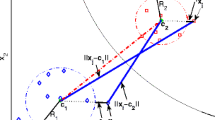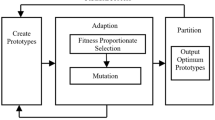Abstract
If all bounding hyper-spheres for training data of every class are independent, classification for any test sample is easy to compute with high classification accuracy. But real application data are very complicated and relationships between classification bounding spheres are very complicated too. Based on detailed analysis of relationships between bounding hyper-spheres, a hybrid decision strategy is put forward to solve classification problem of the intersections for multi-class classification based on hyper-sphere support vector machines. First, characteristics of data distribution in the intersections are analyzed and then decision class is decided by different strategies. If training samples of two classes in the intersection can be classified by intersection hyper-plane for two hyper-spheres, then new test samples can be decided by this plane. If training samples of two classes in the intersection can be approximately linearly classified, new test samples can be classified by standard optimal binary-SVM hyper-plane. If training samples of two classes in the intersection cannot be linearly classified, new test samples can be decided by introducing kernel function to get optimal classification hyper-plane. If training examples belong to only one class, then new test samples can be classified by exclusion method. Experimental results show performance of our algorithm is more optimal than hyper-sphere support vector machines with only one decision strategy with relatively low computation cost.
Access this chapter
Tax calculation will be finalised at checkout
Purchases are for personal use only
Similar content being viewed by others
References
Mohanty, S.: Speaker identification using SVM during oriya speech recognition. Int. J. Image, Graph. Signal Process. 10, 28–36 (2015)
Sun, A., Lim, E.P., Liu, Y.: On strategies for imbalanced text classification using SVM: a comparative study. Decis. Support Syst. 48(1), 191–201 (2009)
Hsu, C.W., Lin, C.J.: A comparison of methods for multi-class support vector machines. IEEE Trans. Neural Netw. 13(2), 415–425 (2002)
Vural, V., Dy, J.G.: A hierarchical method for multi-class support vector machines. In: ACM International Conference on Machine Learning, pp. 831–838 (2004)
Chmielnicki, W., Stapor, K.: Combining one-versus-one and one-versus-all strategies to improve multiclass SVM classifier. In: Proceedings of the 9th International Conference on Computer Recognition Systems, pp. 37–45 (2016)
Zhu, M., Wang, Y., Chen, S., Liu, X.: Sphere-structured support vector machines for multi-class pattern recognition. In: Wang, G., Liu, Q., Yao, Y., Skowron, A. (eds.) RSFDGrC 2003. LNCS (LNAI), vol. 2639, pp. 589–593. Springer, Heidelberg (2003). https://doi.org/10.1007/3-540-39205-X_95
Liu, S., Chen, P., Li, K.Q.: Multiple sub-hyper-spheres support vector machine for multi-class classification. Int. J. Wavelets Multiresolut. Inf. Process. 12(3), 1450035 (2014)
Liu, S., Chen, P., Yun, J.: Fuzzy hyper-sphere support vector machine for pattern recognition. ICIC Express Lett. 9(1), 87–92 (2015)
Wu, Q., Jia, C.Y., Zhang, A.F.: An improved algorithm based on sphere structure SVMs and simulation. J. Syst. Simul. (Chinese) 20(2), 345–348 (2008)
UCI repository of machine learning databases. http://www.ics.uci.edu/mlearn/. Accessed 1 May 2020
Acknowledgement
This research was funded by the Natural Science Foundation of Liaoning Province, China (grant no. 2019-ZD-0175).
Author information
Authors and Affiliations
Corresponding author
Editor information
Editors and Affiliations
Rights and permissions
Copyright information
© 2020 Springer Nature Switzerland AG
About this paper
Cite this paper
Liu, S., Chen, P. (2020). Hyper-Sphere Support Vector Classifier with Hybrid Decision Strategy. In: Yang, H., Pasupa, K., Leung, A.CS., Kwok, J.T., Chan, J.H., King, I. (eds) Neural Information Processing. ICONIP 2020. Communications in Computer and Information Science, vol 1332. Springer, Cham. https://doi.org/10.1007/978-3-030-63820-7_8
Download citation
DOI: https://doi.org/10.1007/978-3-030-63820-7_8
Published:
Publisher Name: Springer, Cham
Print ISBN: 978-3-030-63819-1
Online ISBN: 978-3-030-63820-7
eBook Packages: Computer ScienceComputer Science (R0)




